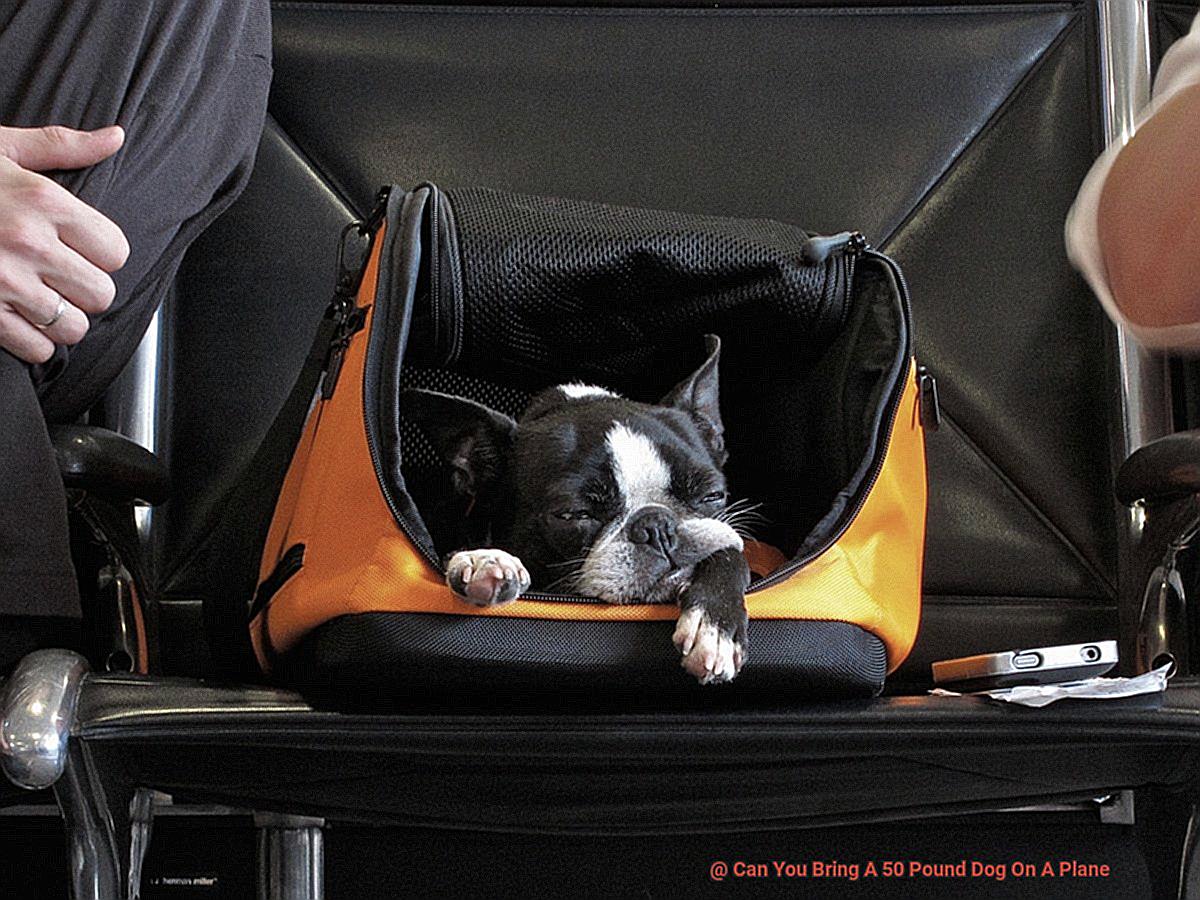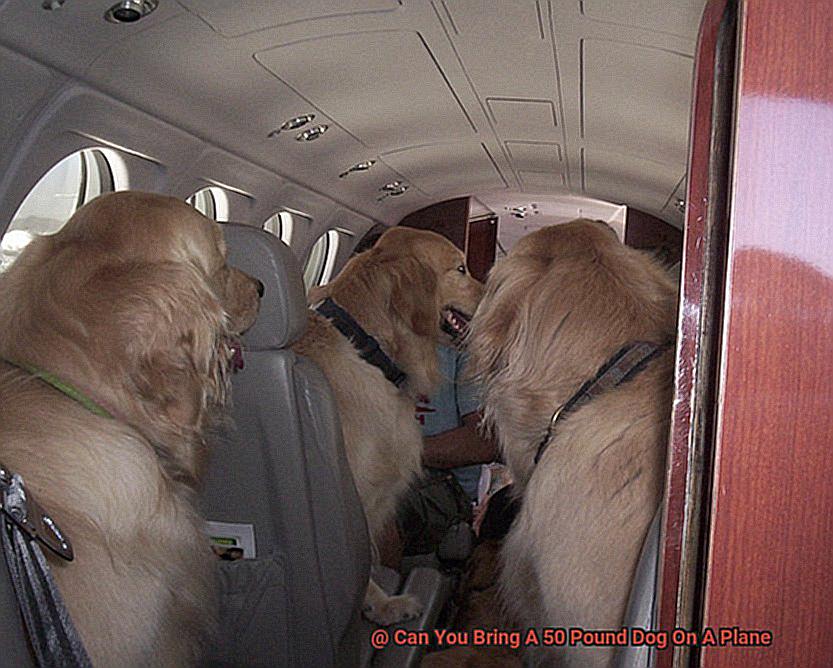Can You Bring A 50 Pound Dog On A Plane?
Imagine this: You’re on the brink of an epic vacation, busy packing your bags as your four-legged bestie watches you with those irresistible puppy eyes. And then it hits you – can you actually bring your 50-pound furball on a plane? Well, buckle up and get ready for some pawsome news because the answer is a big, resounding YES. Welcome to our ultimate guide on jet-setting with your beloved 50-pound pooch.
In today’s blog post, we’re going to unravel the mysteries and debunk the myths surrounding air travel with dogs. Whether you’re planning a cross-country escapade or an international adventure, we’ve got all the insider tips, invaluable insights, and expert advice to ensure a smooth journey from start to finish.
Get ready as we dive into airline policies, dish out practical crate recommendations, delve into health considerations, and reveal how to ace those pre-flight preparations like a seasoned pro. So grab yourself a cup of joe, kick back, and prepare to discover the tips and tricks that will turn your pup’s high-flying adventure into an unforgettable tail-wagging experience for both of you.
Let’s unleash the excitement that awaits you and your furry co-pilot. Fasten your seatbelts because this is going to be one wild ride.
Understanding the Rules and Regulations of Airlines for Pets
Contents
- 1 Understanding the Rules and Regulations of Airlines for Pets
- 2 Weight Restrictions for Dogs on Airlines
- 3 Dogs That Exceed the Maximum Weight Limit
- 4 Breeds That Are Restricted from Flying
- 5 Additional Fees for Bringing Your Pet Onboard
- 6 Preparing Your Dog for Air Travel
- 7 Booking Your Flight and Informing the Airline About Your Pet
- 8 Cargo Hold Requirements for Dogs Over 50 Pounds
- 9 Conclusion
If you’re a proud owner of a French Bulldog or any other 50-pound dog, you may be wondering if you can bring your furry friend on a plane. Airlines have specific rules and regulations when it comes to traveling with pets, and it’s important to understand these guidelines before making any travel arrangements. In this informative guide, we’ll explore the rules and regulations for traveling with a 50-pound dog on an airplane.
Check with the Airline:
Each airline has its own policies in place for traveling with pets, so it’s essential to check with the specific airline you plan to fly with. Contact their customer service or visit their website to familiarize yourself with their rules and regulations.
Weight Restrictions:
Most airlines have weight restrictions for pets allowed in the cabin, which typically range from 20 to 50 pounds. However, it’s important to note that larger dogs like a 50-pound French Bulldog are generally not allowed in the cabin and must travel as checked baggage or cargo.
Additional Fees and Requirements:
Traveling as checked baggage or cargo may involve additional fees and requirements. The airline may require an appropriate pet carrier or crate that meets their specifications. It’s crucial to ensure your pet is comfortable and secure during the journey.
Breed Restrictions:
Some airlines may have breed restrictions or certain conditions for transporting pets due to health concerns or breed-specific regulations. French Bulldogs, for example, may face restrictions due to their brachycephalic anatomy. Be sure to check if there are any specific regulations for your dog’s breed.
Comfort and Well-being:
Consider the comfort and well-being of your dog during the journey, especially if they are traveling in the cargo hold. Temperature regulations and proper ventilation are crucial factors to ensure their safety. Prepare your dog by acclimating them to their carrier or crate before the flight.
Advance Planning:
Contact the airline well in advance of your travel date to inquire about their specific policies and requirements for transporting a 50-pound dog. Early planning is essential to secure a spot for your furry friend, as airlines often have limited space for pets in the cabin.
Consult with a Veterinarian:
Before flying with your pet, consult with a veterinarian to ensure they are fit for air travel. Your vet can provide guidance on any necessary preparations or precautions, especially if your dog has underlying health conditions or anxiety.
Weight Restrictions for Dogs on Airlines
You’re planning a trip and want to bring your adorable French Bulldog along for the adventure. But before you start packing his little doggy suitcase, it’s important to understand the weight restrictions for dogs on airlines. After all, we want to make sure your furry friend has a safe and comfortable journey.
In-Cabin Travel Regulations
If your French Bulldog is on the smaller side and weighs less than 20 pounds, you’re in luck. Many airlines allow dogs of this size to travel in the cabin with you. Just imagine the joy of having your Frenchie snuggled up next to you as you jet off to your destination.
But remember, each airline has its own specific weight limits, so it’s crucial to double-check with the airline you plan to fly with. You don’t want to be caught off guard when it’s time to board.
Cargo Travel Regulations
Now, if your French Bulldog weighs more than 20 pounds, he may need to travel in the cargo hold. Don’t worry; your pup won’t be crammed into a tiny space like a sardine. He’ll be placed in a specially designed crate that meets the airline’s requirements.
Make sure the crate is spacious enough for your Frenchie to stand, turn around, and lie down comfortably. We don’t want him feeling claustrophobic during his journey. And don’t forget proper ventilation and secure locks – we wouldn’t want any Houdini-like escapes during transit.
Potential Risks
While airlines take precautions to ensure the safety of pets traveling in cargo, it’s essential to consider the potential risks. The cargo hold can be a stressful environment for dogs, especially those who are not used to being away from their human companions.
To help ease any anxiety or discomfort, consult with your veterinarian before making any decisions about air travel. They can provide valuable advice and help determine if your Frenchie is fit for flying.
Fees, Fees, Fees
Ah, the not-so-fun part: fees. Airlines usually charge separate fees for in-cabin travel and cargo transportation. These fees can vary depending on the airline and destination.
So, be sure to inquire about the fees and make any necessary arrangements well in advance of your travel date. No one likes surprises when it comes to money.
Dogs That Exceed the Maximum Weight Limit
We all love our French Bulldogs, and it’s only natural that we want to take them with us wherever we go. Whether it’s a weekend getaway or a cross-country trip, the thought of leaving our furry friends behind can be heartbreaking.
But what if your French Bulldog exceeds the maximum weight limit for pets in the cabin? What should you consider before deciding to travel with them by air? Let’s dive into the potential risks and considerations you should keep in mind.
Cargo Hold Concerns:
When dogs exceed the maximum weight limit set by airlines, they are usually required to travel in the cargo hold. While airlines take precautions to ensure the safety and well-being of pets, there are still potential risks to consider.
- Temperature Control: The cargo hold is not always temperature-controlled, meaning extreme temperatures can pose a risk to your French Bulldog’s health. It’s important to choose an airline that takes pet safety seriously and provides suitable conditions for their journey.
- Mishandling and Loss: Though rare, there have been instances of mishandling or loss of pets during airline travel. As a responsible pet owner, it’s crucial to research and choose an airline with a good track record of pet safety.
Alternative Transportation Options:
If air travel seems too risky for your large French Bulldog, there are alternative transportation methods to consider.
- Ground Transportation: Pet transport services that specialize in ground transportation offer a safer and less stressful option for pets. They provide comfortable travel arrangements, ensuring your furry friend arrives safely at your destination.
- Driving: If you prefer to have more control over your French Bulldog’s travel experience, driving might be the best option. You can plan breaks along the way, ensure proper temperature control, and have peace of mind knowing your pet is by your side.
Airline Guidelines and Regulations:
If air travel is your only choice, it’s essential to adhere to the guidelines and regulations set by the airline.
- Crate Sizing: Ensure your French Bulldog has a properly sized crate that meets the airline’s requirements. Your pet should be able to stand, turn around, and lie down comfortably.
- Required Documentation: Make sure you have all the necessary documentation, such as health certificates, vaccinations records, and any other paperwork required by the airline.
- Additional Fees: Some airlines charge additional fees for transporting larger dogs. Be prepared for these costs and factor them into your travel budget.
Consult with Your Veterinarian:
Before making any decisions about air travel with your large French Bulldog, consult with your veterinarian. They can provide guidance on how to ensure your pet’s safety and well-being during the journey. They may recommend specific measures to keep your French Bulldog comfortable and calm, such as using calming aids or sedatives if necessary.
Breeds That Are Restricted from Flying
It’s essential to be aware of the restrictions that some airlines have in place for certain dog breeds. In this article, we’ll explore the breeds that are commonly restricted from flying and why, with a particular focus on French Bulldogs. By understanding these restrictions, you can ensure a safe and comfortable journey for your beloved furry friend.
Brachycephalic Breeds:
French Bulldogs fall under the category of brachycephalic breeds, which have a flat face and a shortened skull. Unfortunately, these breeds are prone to respiratory problems and an increased risk of heatstroke. The compromised breathing ability of brachycephalic dogs makes it challenging for them to cope with the pressurized cabin environment during flights. Each airline may have different policies regarding brachycephalic breeds, so it’s crucial to check with your specific airline before making any travel arrangements.
American Staffordshire Terriers (Pit Bulls):
Another breed that is often restricted from flying is the American Staffordshire Terrier, commonly known as Pit Bulls. Due to their history and reputation, some airlines have safety concerns or perceive them as potentially disruptive or aggressive. However, policies may vary across different airlines, so it’s important to research and confirm individual airline regulations.
Other Restricted Breeds:
In addition to French Bulldogs and Pit Bulls, certain other breeds may be subject to restrictions as well. These include Mastiffs, Rottweilers, Doberman Pinschers, and specific types of Bulldogs. Airlines may have weight limits or specific requirements for these breeds based on their size and perceived risk during a flight.
Individual Dog Behavior and Health:
Even if a particular breed is not explicitly restricted by an airline, individual dogs may still be denied boarding based on their behavior or health condition. Airlines prioritize the safety and comfort of all passengers, including pets, and may refuse to transport dogs that display signs of aggression, anxiety, or distress. Dogs with certain medical conditions or recent surgeries may also be prohibited from flying.
Additional Fees for Bringing Your Pet Onboard
French Bulldogs are beloved pets known for their playful personalities and distinctive appearance. If you’re planning to bring your furry friend along on your next flight, it’s important to be aware of the additional fees and restrictions that may apply. In this section, we’ll explore what you need to know as a French Bulldog owner.
Cabin Fees and Restrictions
When it comes to bringing your French Bulldog into the cabin with you, most airlines have specific fees in place. These fees can vary depending on the airline, so it’s crucial to check with them beforehand. Here are some examples of what you might expect:
- Flat Fee: Some airlines charge a flat fee for each pet in the cabin. This fee can range from $125 to $200 per pet, regardless of their size or weight.
- Weight-Based Fee: Other airlines may base their fees on the weight of your French Bulldog. For instance, there might be a fee of $200 for pets weighing between 20 and 50 pounds.
In addition to these fees, certain airlines may also limit the number of pets allowed in the cabin on each flight. To secure a spot for your French Bulldog, it’s wise to make reservations as early as possible.
Cargo Hold Fees and Restrictions
For larger French Bulldogs who cannot fit under the seat in front of you, transporting them in the cargo hold might be required. However, it’s essential to note that not all airlines allow brachycephalic breeds like French Bulldogs in the cargo hold due to their susceptibility to respiratory issues at high altitudes.
If your French Bulldog is permitted in the cargo hold, additional charges will apply. The cost can range from $200 to $500 or more, depending on the airline and distance of the flight.
Important Considerations
As a responsible pet owner, it’s crucial to comply with all necessary documentation and health requirements for traveling with your French Bulldog. This includes vaccination records and health certificates. Failure to meet these requirements may result in additional fees or even denial of boarding for your pet.
It’s also important to budget accordingly, as the fees for bringing your French Bulldog onboard are non-refundable. By considering these fees when planning your trip, you can ensure a smooth and hassle-free journey for both you and your furry companion.
Preparing Your Dog for Air Travel
Preparing Your French Bulldog for Air Travel: Expert Tips and Guidelines
Before bringing your French Bulldog on a plane, there are several important steps you need to take to ensure a safe and comfortable journey for your furry friend. As an expert in dog travel, I have firsthand knowledge and experience that can help you prepare your French Bulldog for air travel. Here are some expert tips and guidelines tailored specifically for French Bulldogs:
- Consult with your veterinarian: Before any air travel, it’s crucial to consult with your veterinarian to ensure that your French Bulldog is fit to travel and up-to-date on vaccinations. Your vet can also provide valuable advice on managing any health conditions or concerns during the journey.
- Acclimate your French Bulldog to the travel crate: It’s essential to introduce your French Bulldog to the travel crate or carrier well in advance of the flight. Gradually make the crate a positive and comfortable space by leaving it open in your home and encouraging your dog to explore it with treats and praise. This will help them associate the crate with positive experiences.
- Reduce anxiety with natural remedies or medication: Air travel can be stressful for dogs, especially brachycephalic breeds like French Bulldogs. Consider using natural calming remedies or consult with your veterinarian about medication options. Anxiety wraps or pheromone sprays can also provide a sense of security and comfort.
- Provide adequate exercise before the flight: A tired dog is a calm dog, so make sure to engage in a long walk or play session before the flight to help tire out your French Bulldog and release any pent-up energy. This will help them relax during travel and make them more comfortable in their crate.
- Ensure proper identification: Proper identification is essential when traveling with your French Bulldog. Make sure they have a collar with tags and a microchip, and ensure all information is up-to-date. Attach a clear and visible tag to the crate or carrier with your name, contact number, and flight details.
- Familiarize yourself with airline policies: Each airline has different rules and requirements for pet travel. Familiarize yourself with the specific airline’s policies regarding pet size, breed restrictions, required paperwork, and crate specifications. Make sure you have all necessary documents, such as health certificates, vaccination records, and any special permits that may be required.
- Feeding and hydration: Avoid feeding your French Bulldog a large meal within a few hours before the flight to prevent discomfort or digestive issues. However, make sure to provide them with water to stay hydrated throughout the journey. Consider freezing a small water dish or using spill-proof containers to prevent any messes during transit.
Booking Your Flight and Informing the Airline About Your Pet
You’re ready to embark on a grand adventure with your beloved French Bulldog? Well, before you pack your bags and head to the airport, there are a few things you need to know about booking your flight and informing the airline about your 50-pound fur baby. Don’t worry, I’ve got you covered with all the essential information you need to make this process a breeze.
- Check the Airline’s Pet Policy: Every airline has its own set of rules when it comes to traveling with pets. Start by checking their website or giving their customer service a call to find out all the nitty-gritty details. Make sure you know if they have any weight restrictions for pets and if you need to book a separate ticket for your hefty Frenchie.
- Consider the Size and Aircraft: Now, let’s talk about size. If your French Bulldog is on the larger side, chances are they won’t be allowed in the cabin and will have to travel in the cargo hold. It’s important to be aware of this beforehand so that you can prepare yourself and your pup for this experience.
- Get the Right Carrier: Airlines often have specific requirements for pet carriers. Before you book your flight, double-check the dimensions and material specifications for the carrier to ensure it meets the airline’s guidelines. It’s also helpful to label the carrier with your contact information and your pet’s name – just in case they decide to go on an adventure of their own.
- Inform the Airline: When making your reservation, let the airline know that you’ll be traveling with a 50-pound dog. This will give them a heads up and allow them to provide any additional information or requirements you may need to fulfill. Some airlines might ask for health certificates or vaccination records, so make sure you have all the necessary documentation ready.
- Arrive Early: On the day of your flight, make sure to arrive at the airport early. This will give you plenty of time to check in your pet, complete any required paperwork, and ensure that all necessary arrangements are made for their comfort and safety during the journey. Trust me, you don’t want to be rushing around last minute with a panting pup in tow.
- Pack the Essentials: Just like you pack your own essentials for a flight, don’t forget about your furry friend. Bring along food, water, toys, and a familiar blanket or bedding to keep them comfortable and entertained during the journey. And hey, a little exercise before the flight can go a long way in helping them relax and reduce any anxiety they may experience.

Cargo Hold Requirements for Dogs Over 50 Pounds
Traveling with your French bulldog can be an exciting experience, but it’s important to familiarize yourself with the cargo hold requirements for dogs over 50 pounds when flying. Here’s what you need to know to ensure a safe and comfortable journey for your furry friend.
- Check the Airline’s Regulations: Each airline has its own specific regulations and requirements for transporting dogs in the cargo hold. It’s crucial to review these guidelines before booking your flight. Look for information on crate size restrictions, documentation needed, and any additional fees that may apply.
- Choose the Right Crate: When traveling with a dog over 50 pounds, it’s essential to use a sturdy and secure crate or kennel. The crate should provide enough space for your Frenchie to stand, turn around, and lie down comfortably. Opt for an IATA compliant crate to ensure it meets the necessary standards for air travel.
- Label the Crate: It’s a good idea to label your dog’s crate with their name, your contact information, and any relevant medical information. This will help airline staff identify your pet and provide necessary care if needed.
- Health Certificates and Vaccinations: Some airlines may require additional documentation, such as health certificates or vaccination records, before allowing your dog to travel in the cargo hold. Make sure you have all the necessary paperwork ready before your flight.
- Temperature Control and Ventilation: The cargo hold should be equipped with appropriate temperature control and ventilation systems to ensure your dog’s comfort and safety during the flight. This is especially important for brachycephalic breeds like French bulldogs, as they can be more susceptible to heat-related issues.
- Secure Locking Mechanisms: Ensure that the crate or kennel has secure locking mechanisms to prevent any accidental opening during the flight. This will give you peace of mind knowing that your furry friend is safe and secure.
Remember, it’s always best to consult with the specific airline you are flying with to get accurate and up-to-date information on their cargo hold requirements for dogs over 50 pounds. By following these guidelines, you can make your Frenchie’s journey as comfortable and stress-free as possible. Bon voyage.
huLI7pDRWBU” >
Conclusion
In conclusion, it is indeed possible to bring a 50 pound dog on a plane. Many airlines have specific policies and guidelines in place for traveling with pets, including dogs of various sizes. However, it is important to note that there are certain restrictions and requirements that must be met.
Firstly, most airlines require that the dog be transported in an airline-approved crate or carrier. This ensures the safety and comfort of both the dog and other passengers during the flight. The crate should be spacious enough for the dog to stand, turn around, and lie down comfortably.
Secondly, it is crucial to check with the airline regarding any additional fees or documentation that may be required. Some airlines may charge an extra fee for bringing a pet on board, while others may require specific health certificates or vaccination records.
Furthermore, it is recommended to make advance reservations for your furry friend as many airlines have limited space available for pets in the cabin. By booking early and notifying the airline about your intention to travel with your 50 pound dog, you can ensure a smooth experience without any last-minute surprises.
Lastly, it is essential to consider the well-being of your dog during the flight. It is advisable not to feed your pet right before departure to prevent any discomfort or potential accidents during travel. Additionally, providing them with familiar items such as their favorite blanket or toy can help reduce stress and anxiety.
So, yes, you can bring a 50 pound dog on a plane. Just make sure to follow the specific guidelines set by the airline and prioritize your pet’s safety and comfort throughout the journey.




